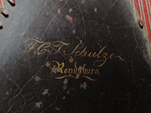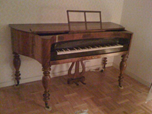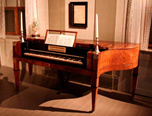Square piano, Fr. C. Theodor Schulze, Rendsborg, 1830s, KH 510
There are always reasons why certain non-Swedish instruments are added to the collections in Klaverens Hus. We have not been isolated in this country, but part of a larger piano world, and it is important to be able to place our own production in a larger context. Conversely, international research has its eyes on instruments in Sweden for the possibility that there may be internationally significant pianos here. One such, world-unique instrument is square piano signed Franz Carl Theodor Schulze, Rendsborg in Schleswig (then Danish), which has his patent for a cast iron frame from 1833 (KH 510).
Ever since American Alpheus Babcock introduced his all-cast iron frame in 1825, piano makers have struggled with the task of improving construction, but it wasn’t until 1855 that the cast iron frame combined with cross-stringing gained traction. The road there was long, and there were many who tackled the problem. Piano makers in our sibling-country Denmark have been active in the field, where C.C. Hornung’s solution was at the international forefront. Before him Fr. C. Theodor Schulze is also worth remembering in this context.
He was a piano maker and resident in the town of Rendsborg in Schleswig since 1816. On August 20, 1833, he submitted to Industri og Fabriksfaget inom Generaltoldkammer og Kommercekollegium in Copenhagen a patent application for five years of exclusive rights in Scheswig and Holstein, for his special invention of an iron frame. During the years in Rendsborg, he says in his application, he had thought about how he could construct instruments with parts of metal, so that they both kept their tuning better and at the same time improved tone and timbre. Now he thought he had the solution.




He received his patent quite quickly, on September 18, 1833, and the news spread throughout the engineering world. So e.g. informs the Allgemeine polytechnische Zeitung 1834/1 that Schulze “ein 5jähriges Privilegium für seine ichtunge Verbesserung der Pianoforte ertheilt worden. Er schiesst das ganze Saitensystem in Gusseisen ein, whäum die Haltbarkeit und Schönheit des Tons ausserordentlich gewinnt; die Klaviatur wird in die Mitte dieses Instrumentes gebracht” (received a five-year priviledge for his important improvement of the pianoforte. He surrounds the entire string system with cast iron, whereby the tone gains considerably in durability and beauty. The keyboard sits in the middle of the instrument).
Schulze’s design has previously only been known through the patent with its drawing. That an instrument built according to his patent has now (2010) been found is a world sensation!
Schulze later made the entire frame in brass, but this is cast and thus quite early. Otherwise, the scope, the suspension plate and the design of the flap with the text Patent Forte-Piano differentiate between the instrument and the drawing. The wrestplank is placed at the front edge of the instrument, as on reverse rubenesque square pianos. The metal frame lies above this, so that the tuning screws go through the metal into the wood and are supported by the frame. It is an important detail in the construction, which Schulze is an early adoptee. In Nyt Magazin for Kunstnere og Haandvaerkere 1839 (vol. 3, p. 344) his squares are praised for the smoothness of the tone and bright and sonorous treble even in the highest register. The fact that an instrument has now been identified opens up opportunities for closer study and assessment of its construction and musical qualities.
References:
Dorthe Facon Möller, ”Det danske pianoforte frem til 1914 – et håndvaerk og en industri”. Diss. Forlaget Falcon 2004, s. 88-91.